Abstract
The reaction of iodoacetic acid with bovine lutropin (luteinizing hormone) at pH 3.0 was specific for methionine residues; it was slow and reached its equilibrium after 12 h at 37 degrees C. The number of modified methionine residues increased proportionately with the amount of the alkylating reagent in the reaction mixture. In the presence of a 20-fold molar excess of iodoacetic acid with respect to methionine, essentially all methionine residues in both subunits of bovine lutropin were carboxymethylated. Studies of various recombinations of modified and native alpha and beta subunits showed that methionine residues in bovine lutropin were not essential for interactions between subunits. Various recombinants were characterized by polyacrylamide-gel electrophoresis and gel filtration of Sephadex G-100. Immunological cross-reactivity by radioimmunoassay of the recombinants of modified alpha and beta subunits was relatively similar to that of the native subunits. However, the biological activity measured by receptor-site binding of the recombinants of alpha and beta chains with a total of three alkylated methionine residues was less than 5% of the activity of native lutropin. It is noteworthy that recombinants of a modified subunit and a native counterpart subunit regenerated 20-30 % of biological activity. These findings suggested that at least 1-2 methionine residues in each subunit are involved in the hormone-receptor interaction for bovine lutropin.
Full text
PDF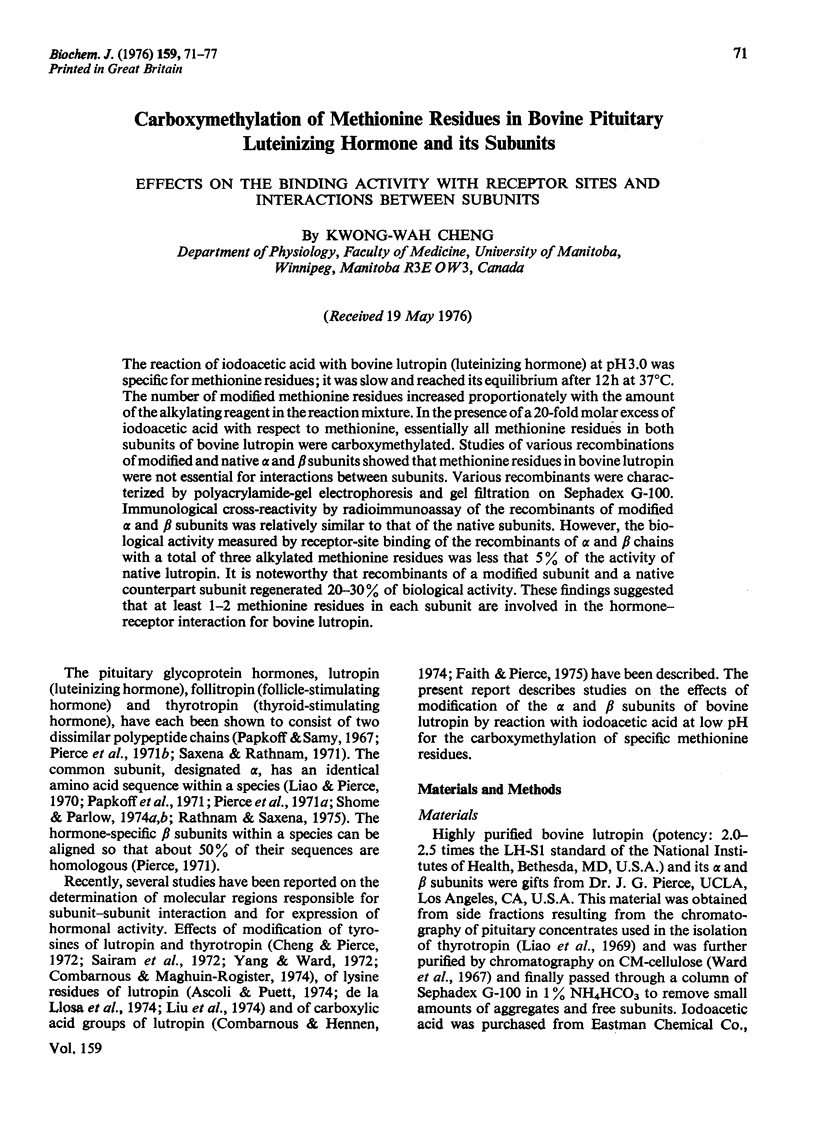
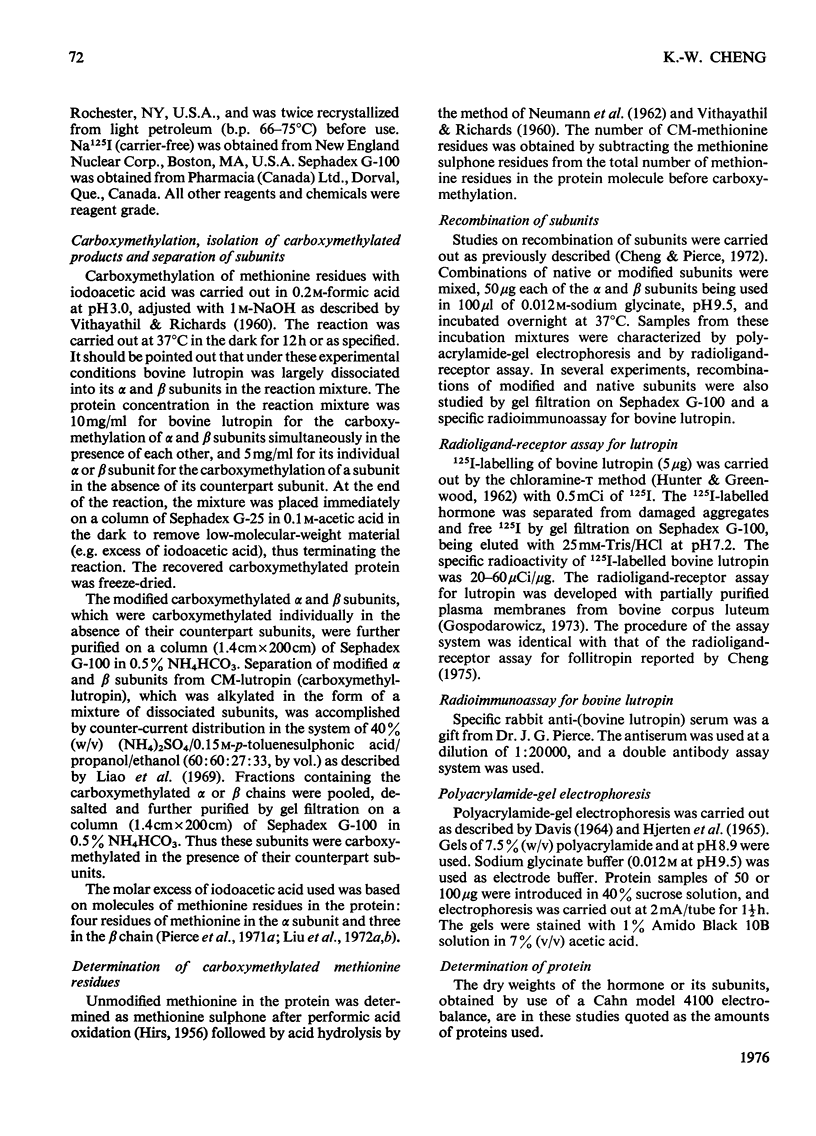
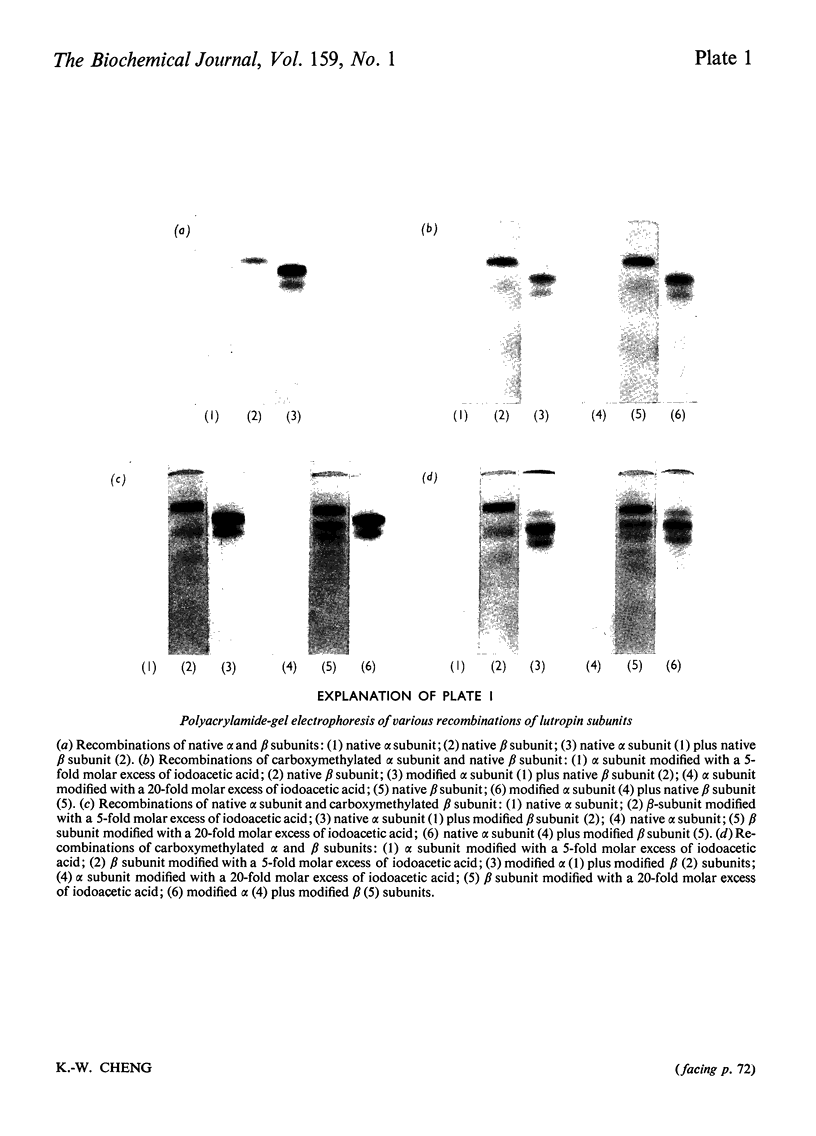
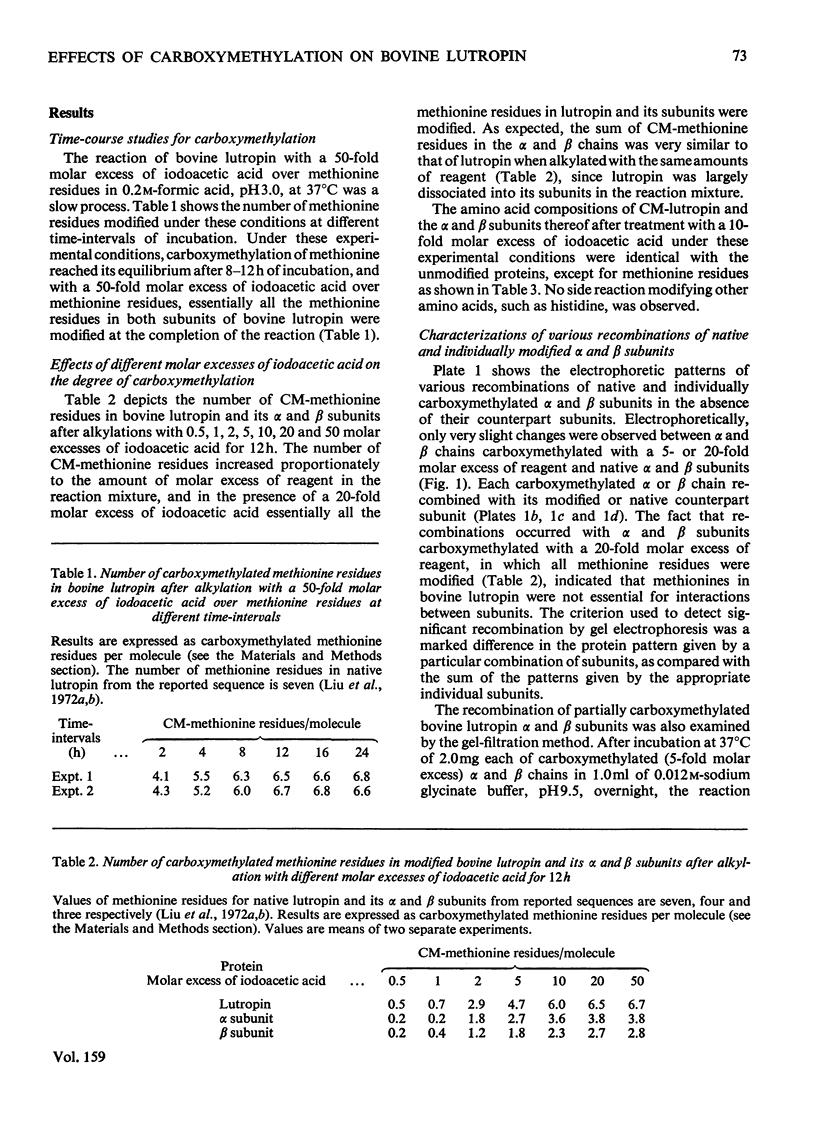
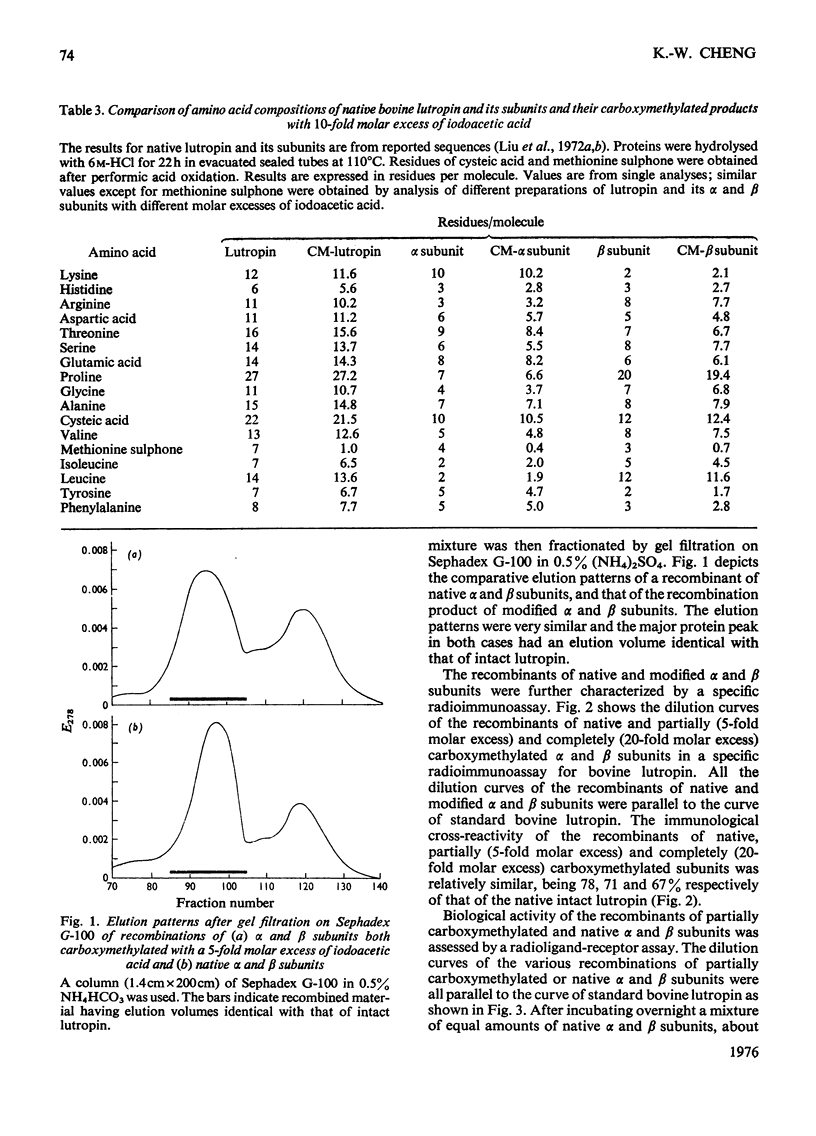
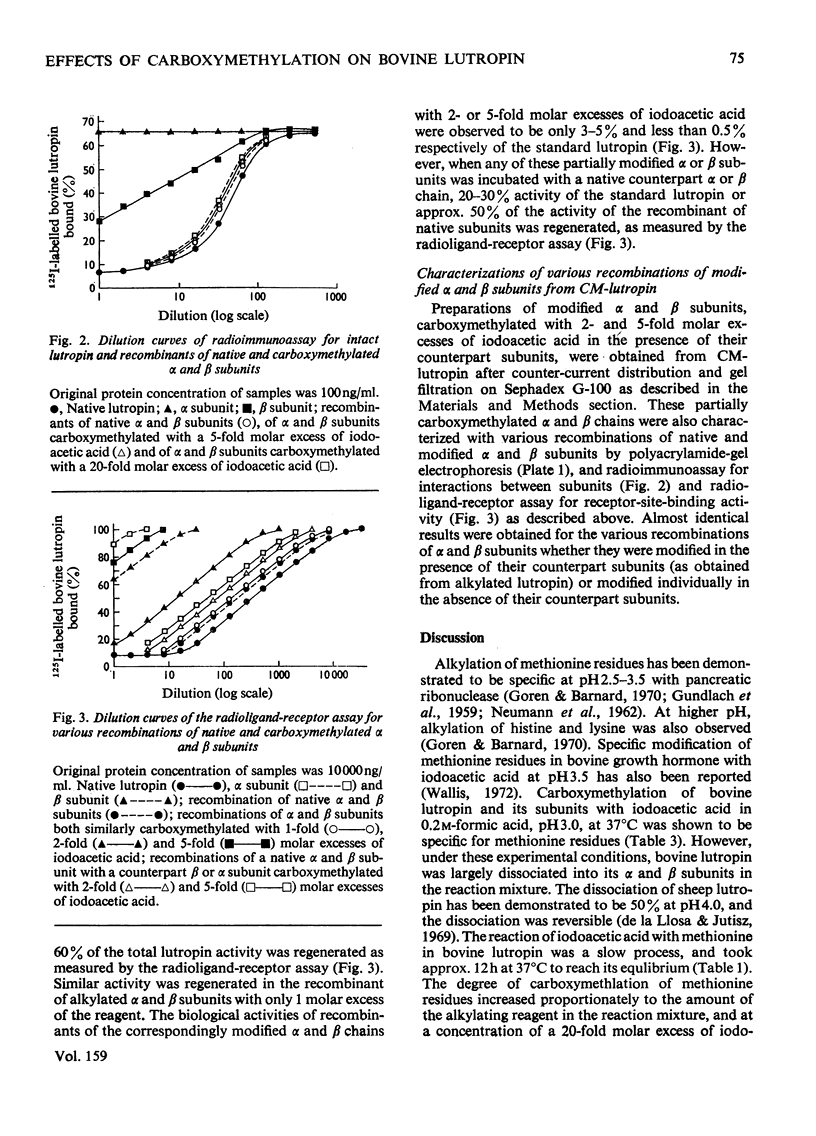
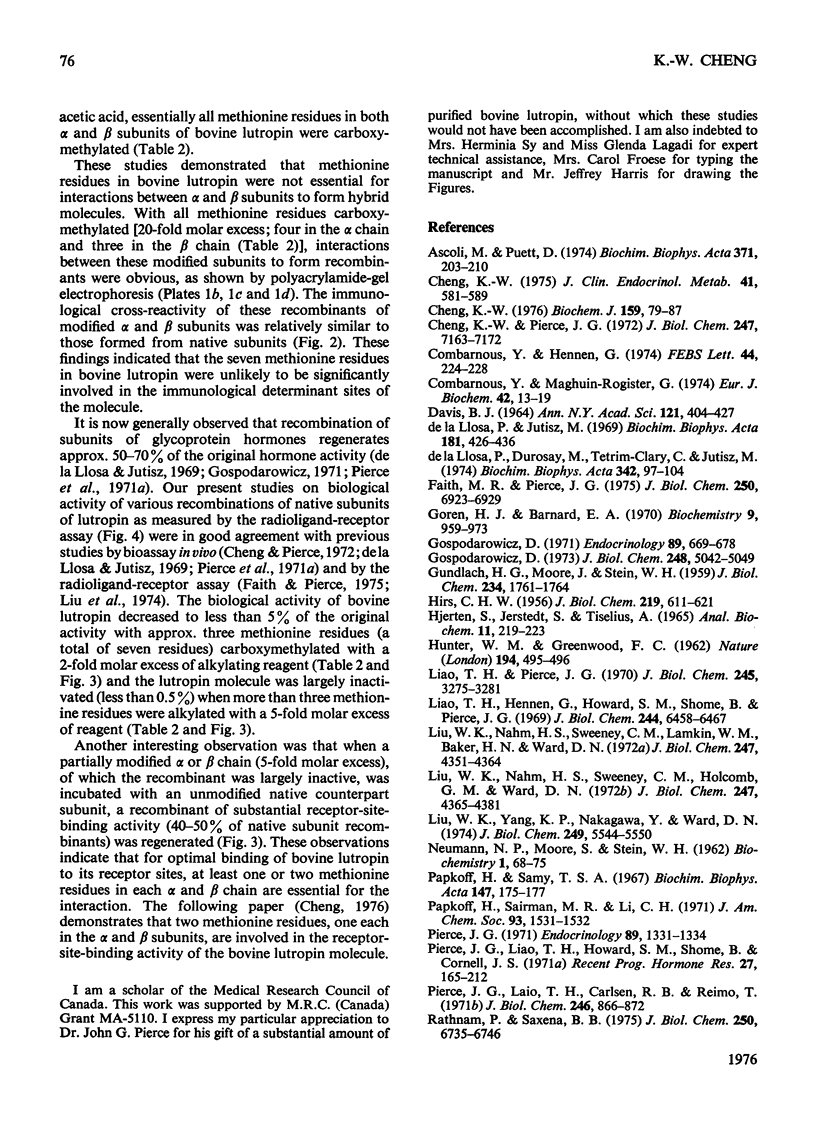
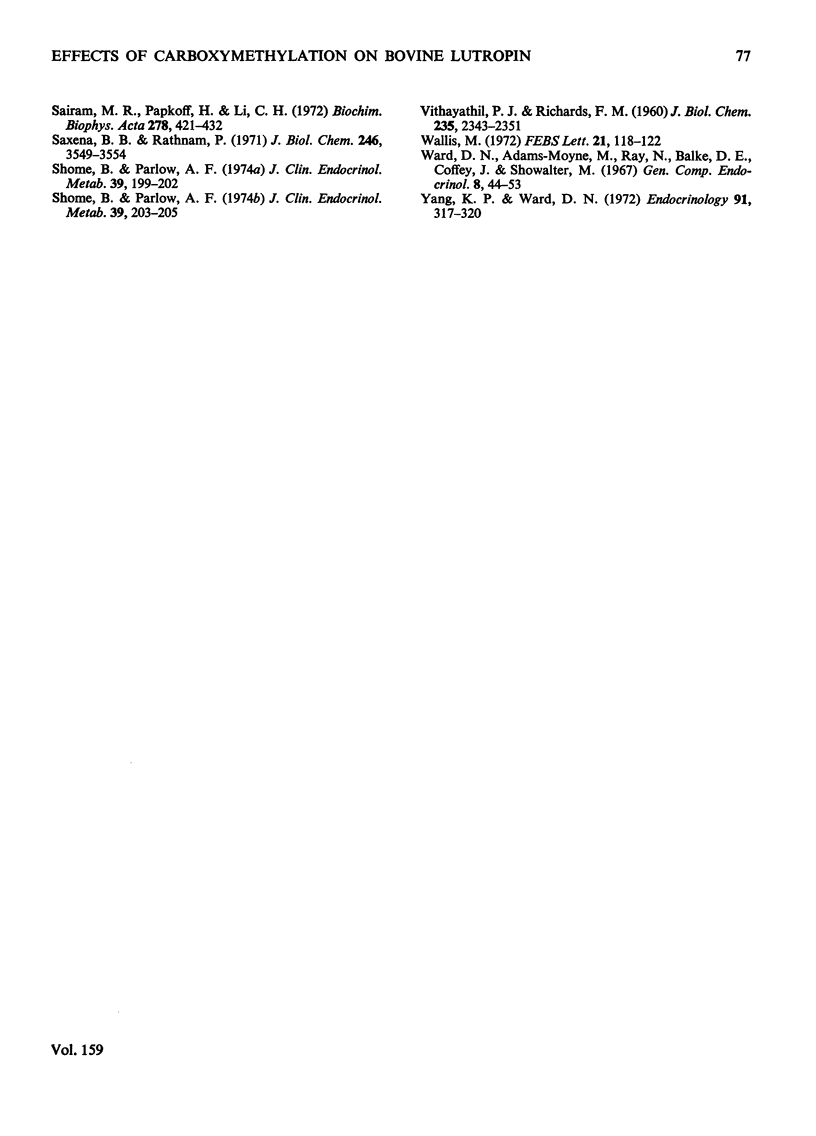
Images in this article
Selected References
These references are in PubMed. This may not be the complete list of references from this article.
- Ascoli M., Puett D. Tritium labeling of luteinizing hormone by reductive methylation. Biochim Biophys Acta. 1974 Nov 5;371(1):203–210. doi: 10.1016/0005-2795(74)90169-x. [DOI] [PubMed] [Google Scholar]
- Cheng K. W. A radioreceptor assay for follicle-stimulating hormone. J Clin Endocrinol Metab. 1975 Sep;41(3):581–589. doi: 10.1210/jcem-41-3-581. [DOI] [PubMed] [Google Scholar]
- Cheng K. W. Carboxymethylation of methionine residues in bovine pituitary luteinizing hormone and its subunits. Location of specifically modified methionine residues. Biochem J. 1976 Oct 1;159(1):79–87. doi: 10.1042/bj1590079. [DOI] [PMC free article] [PubMed] [Google Scholar]
- Cheng K. W., Pierce J. G. The reaction of tetranitromethane with pituitary, luteinizing and thyroid-stimulating hormones. J Biol Chem. 1972 Nov 25;247(22):7163–7172. [PubMed] [Google Scholar]
- Combarnous Y., Hennen G. Luteinizing hormone derivatives with covalently-linked subunits. FEBS Lett. 1974 Aug 25;44(2):224–228. doi: 10.1016/0014-5793(74)80730-1. [DOI] [PubMed] [Google Scholar]
- Combarnous Y., Maghuin-Rogister G. Luteinizing hormone. 2. Relative reactivities of tyrosyl residues of the porcine hormone towards iodination. Eur J Biochem. 1974 Feb 15;42(1):13–19. doi: 10.1111/j.1432-1033.1974.tb03308.x. [DOI] [PubMed] [Google Scholar]
- De la Llosa P., Durosay M., Tertrin-Clary C., Jutisz M. Chemical modification of lysine residues in ovine luteinizing hormone. Effect on biological activity. Biochim Biophys Acta. 1974 Mar 14;342(1):97–104. doi: 10.1016/0005-2795(74)90110-x. [DOI] [PubMed] [Google Scholar]
- De la Llosa P., Jutisz M. Reversible dissociation into subunits and biological activity of ovine luteinizing hormone. Biochim Biophys Acta. 1969 Jul 1;181(2):426–436. doi: 10.1016/0005-2795(69)90276-1. [DOI] [PubMed] [Google Scholar]
- Faith M. R., Pierce J. G. The carboxylic acid groups of bovine luteinizing hormone. The effects of their modification on receptor site binding and subunit-subunit interaction. J Biol Chem. 1975 Sep 10;250(17):6923–6929. [PubMed] [Google Scholar]
- GUNDLACH H. G., MOORE S., STEIN W. H. The reaction of iodoacetate with methionine. J Biol Chem. 1959 Jul;234(7):1761–1764. [PubMed] [Google Scholar]
- Goren H. J., Barnard E. A. Relation of reactivity to structure in pancreatic ribonuclease. I. An analysis of the various reactions with bromoacetate in the pH range 2-7. Biochemistry. 1970 Feb 17;9(4):959–973. doi: 10.1021/bi00806a036. [DOI] [PubMed] [Google Scholar]
- Gospodarowicz D. Immunologic and steroidogenic activity of the luteinizing hormone (LH) compared to its two subunits: CI and CII. Endocrinology. 1971 Sep;89(3):669–678. doi: 10.1210/endo-89-3-669. [DOI] [PubMed] [Google Scholar]
- Gospodarowicz D. Properties of the luteinizing hormone receptor of isolated bovine corpus luteum plasma membranes. J Biol Chem. 1973 Jul 25;248(14):5042–5049. [PubMed] [Google Scholar]
- HIRS C. H. The oxidation of ribonuclease with performic acid. J Biol Chem. 1956 Apr;219(2):611–621. [PubMed] [Google Scholar]
- HUNTER W. M., GREENWOOD F. C. Preparation of iodine-131 labelled human growth hormone of high specific activity. Nature. 1962 May 5;194:495–496. doi: 10.1038/194495a0. [DOI] [PubMed] [Google Scholar]
- Hjertén S., Jerstedt S., Tiselius A. Some aspects of the use of "continuous" and "discontinuous" buffer systems in polyacrylamide gel electrophoresis. Anal Biochem. 1965 May;11(2):219–223. doi: 10.1016/0003-2697(65)90008-4. [DOI] [PubMed] [Google Scholar]
- Liao T. H., Hennen G., Howard S. M., Shome B., Pierce J. G. Bovine thyrotropin. Countercurrent distribution and a comparison with the isolated subunits of luteinizing hormone. J Biol Chem. 1969 Dec 10;244(23):6458–6467. [PubMed] [Google Scholar]
- Liao T. H., Pierce J. G. The presence of a common type of subunit in bovine thyroid-stimulating and luteinizing hormones. J Biol Chem. 1970 Jul 10;245(13):3275–3281. [PubMed] [Google Scholar]
- Liu W. K., Nahm H. S., Sweeney C. M., Holcomb G. N., Ward D. N. The primary structure of ovine luteinizing hormone. II. The amino acid sequence of the reduced, S-carboxymethylated A-subunit (LH- ). J Biol Chem. 1972 Jul 10;247(13):4365–4381. [PubMed] [Google Scholar]
- Liu W. K., Nahm H. S., Sweeney C. M., Lamkin W. M., Baker H. N., Ward D. N. The primary structure of ovine luteinizing hormone. I. The amino acid sequence of the reduced and S-aminoethylated S-subunit (LH- ). J Biol Chem. 1972 Jul 10;247(13):4351–4364. [PubMed] [Google Scholar]
- Liu W. K., Yang K. P., Nakagawa Y., Ward D. N. The role of the amino group in subunit association and receptor site interaction for ovine luteinizing hormone as studied by acylation. J Biol Chem. 1974 Sep 10;249(17):5544–5550. [PubMed] [Google Scholar]
- NEUMANN N. P., MOORE S., STEIN W. H. Modification of the methionine residues in ribonuclease. Biochemistry. 1962 Jan;1:68–75. doi: 10.1021/bi00907a011. [DOI] [PubMed] [Google Scholar]
- Papkoff H., Sairam M. R., Li C. H. Amino acid sequence of the subunits of ovine pituitary interstitial cell-stimulating hormone. J Am Chem Soc. 1971 Mar 24;93(6):1531–1532. doi: 10.1021/ja00735a054. [DOI] [PubMed] [Google Scholar]
- Papkoff H., Samy T. S. Isolation and partial characterization of the polypeptide chains of ovine interstitial cell-stimulating hormone. Biochim Biophys Acta. 1967 Sep 19;147(1):175–177. doi: 10.1016/0005-2795(67)90102-x. [DOI] [PubMed] [Google Scholar]
- Pierce J. G. Eli Lilly lecture. The subunits of pituitary thyrotropin--their relationship to other glycoprotein hormones. Endocrinology. 1971 Dec;89(6):1331–1344. doi: 10.1210/endo-89-6-1331. [DOI] [PubMed] [Google Scholar]
- Pierce J. G., Liao T. H., Carlsen R. B., Reimo T. Comparisons between the alpha chain of bovine thyrotropin and the CI chain of luteinizing hormone. Compositions of tryptic peptides, cyanogen bromide fragments, and carbohydrate moieties. J Biol Chem. 1971 Feb 25;246(4):866–872. [PubMed] [Google Scholar]
- Pierce J. G., Liao T., Howard S. M., Shome B., Cornell J. S. Studies on the structure of thyrotropin: its relationship to luteinizing hormone. Recent Prog Horm Res. 1971;27:165–212. doi: 10.1016/b978-0-12-571127-2.50029-8. [DOI] [PubMed] [Google Scholar]
- Rathnam P., Saxena B. B. Primary amino acid sequence of follicle-stimulating hormone from human pituitary glands. I. alpha subunit. J Biol Chem. 1975 Sep 10;250(17):6735–6746. [PubMed] [Google Scholar]
- Sairam M. R., Papkoff H., Li C. H. Reaction of ovine interstitial cell stimulating hormone with tetranitromiethane. Biochim Biophys Acta. 1972 Oct 31;278(3):421–432. doi: 10.1016/0005-2795(72)90002-5. [DOI] [PubMed] [Google Scholar]
- Saxena B. B., Rathnam P. Dissociation phenomenon and subunit nature of follicle-stimulating hormone from human pituitary glands. J Biol Chem. 1971 Jun 10;246(11):3549–3554. [PubMed] [Google Scholar]
- Shome B., Parlow A. F. Human follicle stimulating hormone (hFSH): first proposal for the amino acid sequence of the alpha-subunit (hFSHa) and first demonstration of its identity with the alpha-subunit of human luteinizing hormone (hLHa). J Clin Endocrinol Metab. 1974 Jul;39(1):199–202. doi: 10.1210/jcem-39-1-199. [DOI] [PubMed] [Google Scholar]
- Shome B., Parlow A. F. Human follicle stimulating hormone: first proposal for the amino acid sequence of the hormone-specific, beta subunit (hFSHb). J Clin Endocrinol Metab. 1974 Jul;39(1):203–205. doi: 10.1210/jcem-39-1-203. [DOI] [PubMed] [Google Scholar]
- Wallis M. Carboxymethylation of methionine residues in bovine growth hormone. FEBS Lett. 1972 Mar 15;21(2):118–122. doi: 10.1016/0014-5793(72)80117-0. [DOI] [PubMed] [Google Scholar]
- Yang K. P., Ward D. N. Iodination of ovine luteinizing hormone and its subunits. Endocrinology. 1972 Jul;91(1):317–320. doi: 10.1210/endo-91-1-317. [DOI] [PubMed] [Google Scholar]



